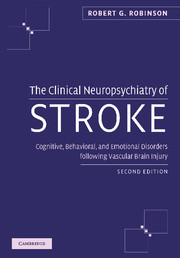 The Clinical Neuropsychiatry of Stroke
The Clinical Neuropsychiatry of Stroke Book contents
- Frontmatter
- Contents
- Preface
- Part I Introduction
- Part II Poststroke depression
- 5 Diagnosis of depression
- 6 Prevalence of depressive disorders
- 7 Phenomenology and specificity of depressive symptoms
- 8 Natural course of depression
- 9 Delayed-onset depression
- 10 Relationship to lesion location
- 11 Relationship of depression to cerebral dominance and structural asymmetries
- 12 Relationship of depression to bilateral hemisphere brain injury
- 13 Relationship of depression to physical impairment
- 14 Relationship to cognitive impairment and treatment
- 15 Relationship of aphasia to depression
- 16 Relationship of depression to social functioning
- 17 Relationship to premorbid risk factors
- 18 Mortality and treatment
- 19 Suicidal thoughts and plans
- 20 Biological markers
- 21 Mechanisms of poststroke depression
- 22 Treatment of poststroke depression
- 23 Prevention of poststroke depression
- Part III Poststroke mania
- Part IV Poststroke anxiety disorders
- Part V Other poststroke disorders
- Index
17 - Relationship to premorbid risk factors
from Part II - Poststroke depression
Published online by Cambridge University Press: 01 October 2009
- Frontmatter
- Contents
- Preface
- Part I Introduction
- Part II Poststroke depression
- 5 Diagnosis of depression
- 6 Prevalence of depressive disorders
- 7 Phenomenology and specificity of depressive symptoms
- 8 Natural course of depression
- 9 Delayed-onset depression
- 10 Relationship to lesion location
- 11 Relationship of depression to cerebral dominance and structural asymmetries
- 12 Relationship of depression to bilateral hemisphere brain injury
- 13 Relationship of depression to physical impairment
- 14 Relationship to cognitive impairment and treatment
- 15 Relationship of aphasia to depression
- 16 Relationship of depression to social functioning
- 17 Relationship to premorbid risk factors
- 18 Mortality and treatment
- 19 Suicidal thoughts and plans
- 20 Biological markers
- 21 Mechanisms of poststroke depression
- 22 Treatment of poststroke depression
- 23 Prevention of poststroke depression
- Part III Poststroke mania
- Part IV Poststroke anxiety disorders
- Part V Other poststroke disorders
- Index
Summary
In previous chapters we have demonstrated the relationship between poststroke depression and stroke-related factors, such as lesion location, severity of physical, or cognitive impairment and social support. Although social support might be argued to be a premorbid risk factor for depression, the dynamic relationship between depression and social functioning makes this an interactive variable with poststroke depression which has already been covered in Chapter 16. In the present chapter, we will focus on both physical and psychological factors that appear to be in existence before the acute stroke event.
It is clear from the discussion in the prior chapters, that stroke-related consequences may play a significant role in poststroke depression but do not explain all of the variants. For example, the meta-analysis of relationship between distances of anterior border of the lesion from the frontal pole and the left hemisphere and severity of depression (Chapter 10, Table 10.3) found a pooled correlation coefficient of -0.53 on the fixed model and -0.59 on the random model. Based on the sample size of 163, these are highly significant correlations. They would explain, however, only about 25–30% of the variance in severity of depression. Similarly, the correlation between depression and severity of impairment in activities of daily living showed a pooled mean correlation coefficient of 0.32.
- Type
- Chapter
- Information
- The Clinical Neuropsychiatry of StrokeCognitive, Behavioral and Emotional Disorders following Vascular Brain Injury, pp. 194 - 206Publisher: Cambridge University PressPrint publication year: 2006


